This 100% Whole Grain Sourdough Spelt Oatmeal Bread, made with a “wild yeast’ starter and whole grain spelt is based on my family’s favorite oatmeal bread recipe.
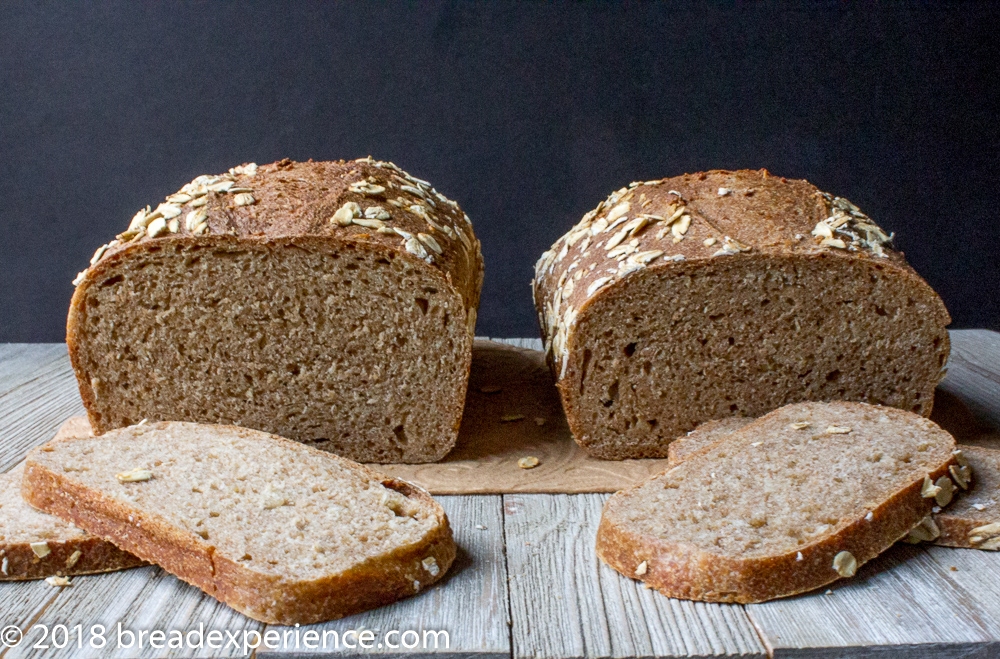
I created this bread for National Oatmeal Month which was in January. I baked the loaves in January but didn’t have time to post about them until later. However, this bread is good anytime whether it’s National Oatmeal Month or not so don’t let that stop you.
The original recipe is made with white flour and baked in a bread machine. My sons still love the original oatmeal bread, but I like to mix things up. So each year or so, I make a new version of this bread using a different technique or grain.
Last year, I converted this loaf to sourdough. This year, I decided to make a sourdough version using whole wheat flour. My whole wheat flour of choice for this test was spelt.
For the first couple of loaves, I used spelt grains that Brian with Belle Valley Ancient Grains graciously sent me for testing. For the other two loaves, I used spelt grains from my storage supply of grains.
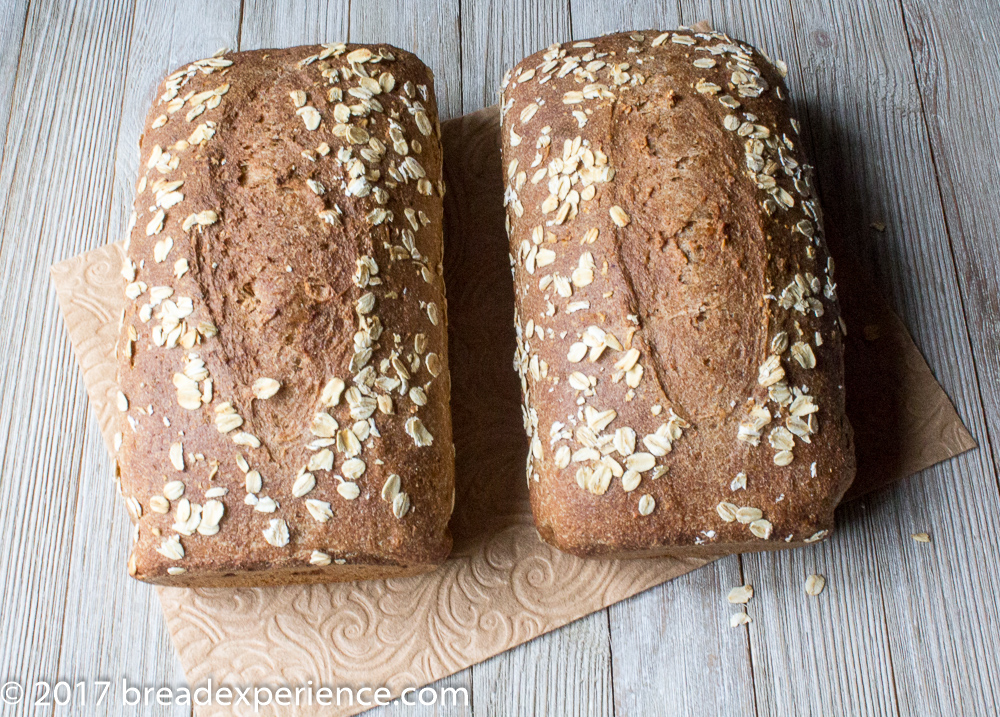
I conducted experiments for several weekends and made two loaves each time using flour milled in my WonderMill Electric Grain Mill for one loaf and flour milled in my MockMill 100 for the other loaf keeping all of the other variables the same.
I’m continuing to work with flour ground in both of these grain mills so I will post about my results in a separate post. However, one thing I will mention is that depending on the coarseness/texture of whole grain flour you use, you may need to add more hydration.
The first batch of loaves turned out to be the best of the three experiments I’ve completed so far. However, the issue with the other two wasn’t because of the grains. It was cold in my kitchen, and I had to adjust to working with the dough in a cold and dry environment. This is something we don’t experience very often in the South. I’m used to working in a humid environment. As a result of the colder weather, my proofer and I have become friends again, and I’ve been adding more hydration to loaves.
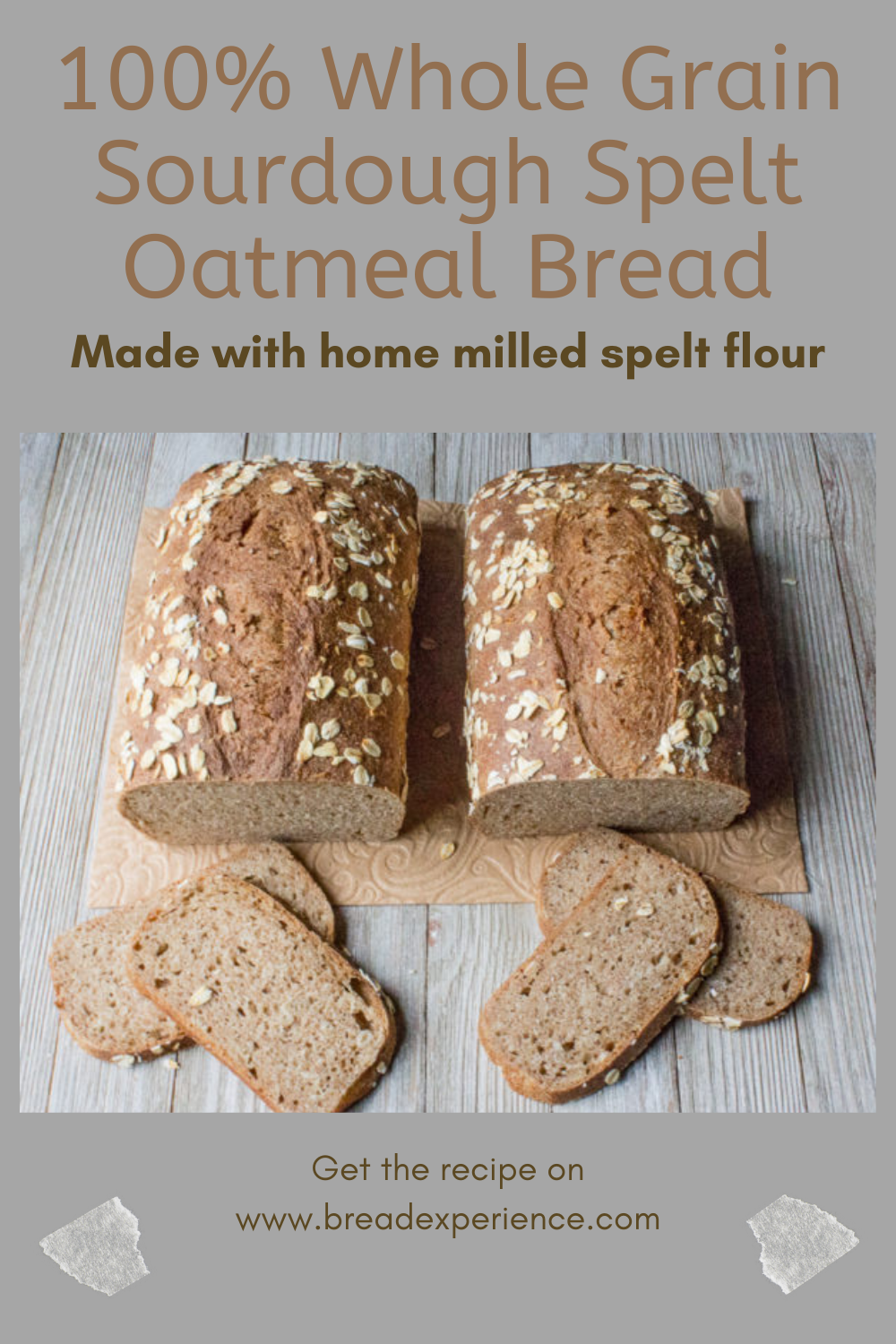
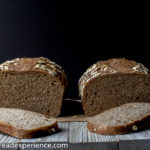
100% Whole Grain Sourdough Spelt Oatmeal Bread
- Yield: 1 Loaf 1x
Description
This 100% Sourdough Whole Grain Spelt Oatmeal Bread, made with a “wild yeast’ starter and whole grain spelt, is based on my family’s favorite oatmeal bread recipe.
Ingredients
Per Loaf:
- 120 grams sourdough starter, active and fed
- 300 grams water + 50 – 100 grams additional, if necessary
- 60 grams honey
- 40 grams / 2 T milk, scalded, then cooled
- 40 / 3 T grams butter, melted
- 480 grams whole wheat spelt flour
- 75 grams rolled oats
- 8–9 grams sea salt
Instructions
First Day:
- Feed your starter the day (or evening) before you plan to make this bread.
Second Day:
- The next afternoon or evening, place 120 grams of the fed starter in a large bowl.
- In a glass measuring cup, heat the milk to boiling, then add the butter, water, and honey to cool it. Stir to fully incorporate.
- In a separate bowl, whisk together the flour, oats, and salt.
- Pour the cooled milk mixture over the starter and stir to break it apart using a wooden spoon or Danish dough whisk. Blend until the starter is completely incorporated into the wet milk mixture.
- Add the flour mixture to the wet ingredients and mix thoroughly.
- Cover the bowl and let the dough rest for 30 minutes.
- After 30 minutes, adjust the hydration if necessary by adding 50 -100 grams additional water. Using wet hands, squish the dough and make imprints in it using your fingertips to allow the water to soak in. Mix thoroughly until all of the water is incorporated into the dough.
- Cover the bowl with plastic wrap or a kitchen towel. Let the dough proof in the bowl for 2 hours at room temperature.
- Fold the dough 3 times every 30 minutes for the first 1 1/2 hours.
- After the final fold, let it rest on the counter for 30 minutes, then cover the bowl tightly with plastic wrap and place it in the refrigerator overnight.
Third Day:
- Remove the bowl from the refrigerator and allow the dough to warm up to room temperature for 2-3 hours, depending on the temperature in your kitchen. It took 3 hours at 65 degrees F. for my dough to warm up to room temp.
- Shape the dough into a loaf and place in a 9×5-inch loaf pan.
- Proof the loaf for 1-2 hours, depending on the temperature in your kitchen. Since my house was cold, I put the loaf pan in a proofer at 70 degrees F. It still wasn’t warming up so I turned the proofer up to 75 degrees F. The dough never reached the top of the pan but it was finally fully proofed when I gently pressed on it. It took several hours.
- Preheat the oven to 375 degrees F.
- Place the loaf in the oven and immediately turn it down to 350 degrees F.
- Bake the loaf at 350 degrees F. for 40 – 50 minutes.
- Remove the loaf to a wire rack to cool completely before slicing.
- Category: Sandwich Loaf
- Method: Sourdough
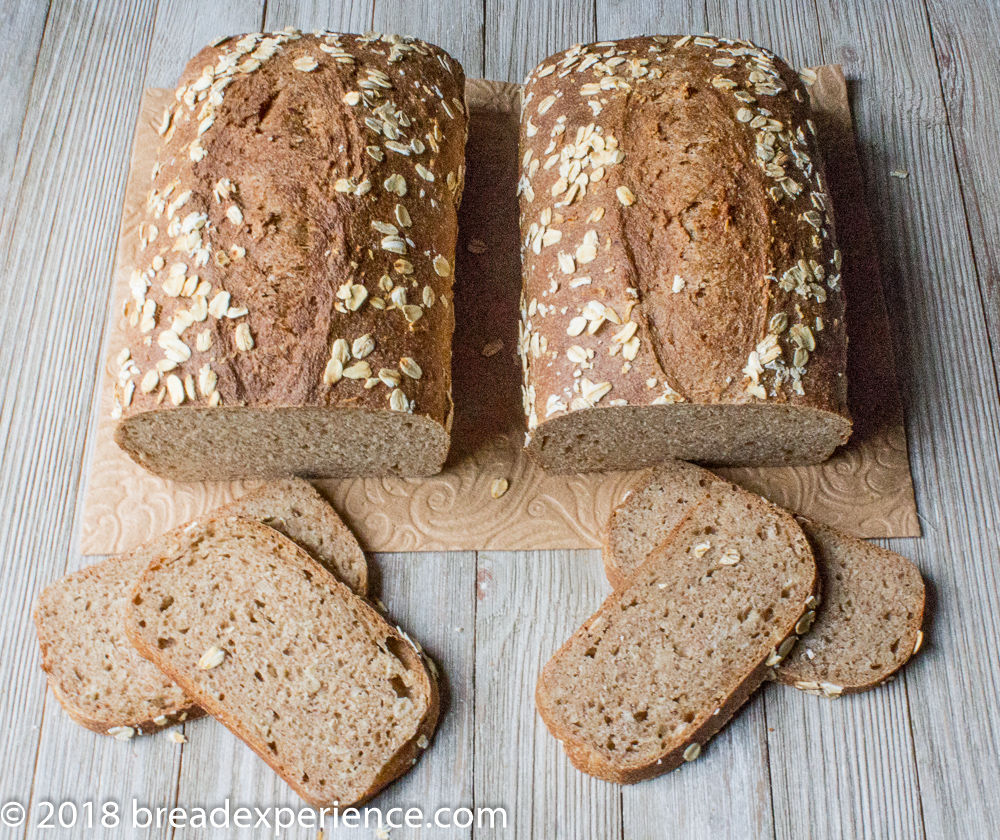
If you like oatmeal bread, you might also like:
Einkorn Bread Machine Oatmeal Bread
Happy Baking!
Cathy
Note: I want to thank Brian of Belle Valley Ancient Grains for providing some spelt grains for this experiment.
Sophiesfoodiefiles says
What a lovely bread recipe! I must make this lovely bread this week!
I think I am going to use my own oat sourdough in here for extra flavour!
Which sourdough did you use?
I am baking your wholemeal spelt sourdough breads with cranberries & sunflower seeds today! the dough is now in the ridge overnight! 🙂 MMMM!
Cathy says
Hi Sophie,
An oat sourdough sounds wonderful! I haven’t tried that. I used my spelt sourdough for this bread, but you should be able to use any sourdough starter. Do let me know how you like the spelt bread with cranberries & sunflower seeds.
Happy Baking!
Cathy
Sophiesfoodiefiles says
Do you use wholemeal spelt sourdough or white splet sourdough. I used white splet sourdough to the wholewheat spelt loaves.
Cathy says
I used a whole meal spelt sourdough starter, but you can use a white spelt sourdough starter and it will be fine.
Sophiesfoodiefiles says
The next time, I will use my whole spelt starter! 🙂 thanks! x
Amy Bode says
I’m wondering how can I tell if the dough needs more hydration after the initial 30 min rest?Also, do you cut the top of the loaves with a lame before baking? Thank you!
Cathy says
I usually check to see if the dough tears and if it does, I’ll add a little more water. Yes, I make scores on top of the loaf to help it open up without tearing during baking.
Connie Shelley says
The use of the words, “whole wheat spelt” confuse me”. Am I to use whole wheat or whole spelt or whole wheat and spelt? For the caramelized onion sourdough spelt and buckwheat bread, do I have to use the onions? I want a spelt/buckwheat combination but would rather not have onion in it.
Thank you….
Cathy says
Any whole wheat flour can be used in this bread. I used spelt grains that I milled into whole wheat spelt flour. I also refer to it as whole grain spelt flour because I didn’t sift out any of the bran. You can use store-bought spelt flour, if preferred.
I used the term “whole wheat spelt” in the list of ingredients so perhaps this was causing some confusion. I just edited it and now it reads “whole wheat spelt flour.”
You do not have to use the onions in the caramelized onion sourdough spelt and buckwheat bread, but you may need to adjust the hydration if you omit them.
Cathy says
It means whole spelt flour. Spelt isn’t usually called whole wheat, though technically it is a subspecies is wheat.
Cathy says
I typically use the term “whole grain” or “whole wheat” spelt flour to differentiate it from white all-purpose spelt flour.
Cindy mays says
On the spelt sourdough oat bread loaves … I don’t see in the directions to score it. But your loaves look scored. Do I score them before baking?
Cathy says
Hi Cindy, you don’t have to score the loaves, but they will open up a bit if you do. Plus, I just like the way it looks.
Carl Harter says
This recipe makes a very nice loaf of bread. I chose to use an oval brotform and bake the bread on a stone, so I modified the recipe. The bulk rise was about ten hours, until the dough had doubled in size. I then formed the dough, put it in the brotform, and let it rise a couple more hours before putting in the refrigerator. The next evening I pulled the dough out and let it warm up for an hour or so before baking. I baked it at 480 for ten minutes with steam, and then 370 for 35 minutes. This loaf kept its shape better than others I have tried, and rose beautifully.
Cathy says
Thank you for sharing your experience with this bread. I like the idea of making it into a hearth bread. Very cool!
Cathy says
By “ Fold the dough at 30 min, 1 hour, and 2 hour intervals.” do you mean fold three times at 30-minute intervals? (2-hour intervals would mean folds at two hours apart!)
Cathy says
That does sound a bit confusing. I have edited the instructions for clarity.